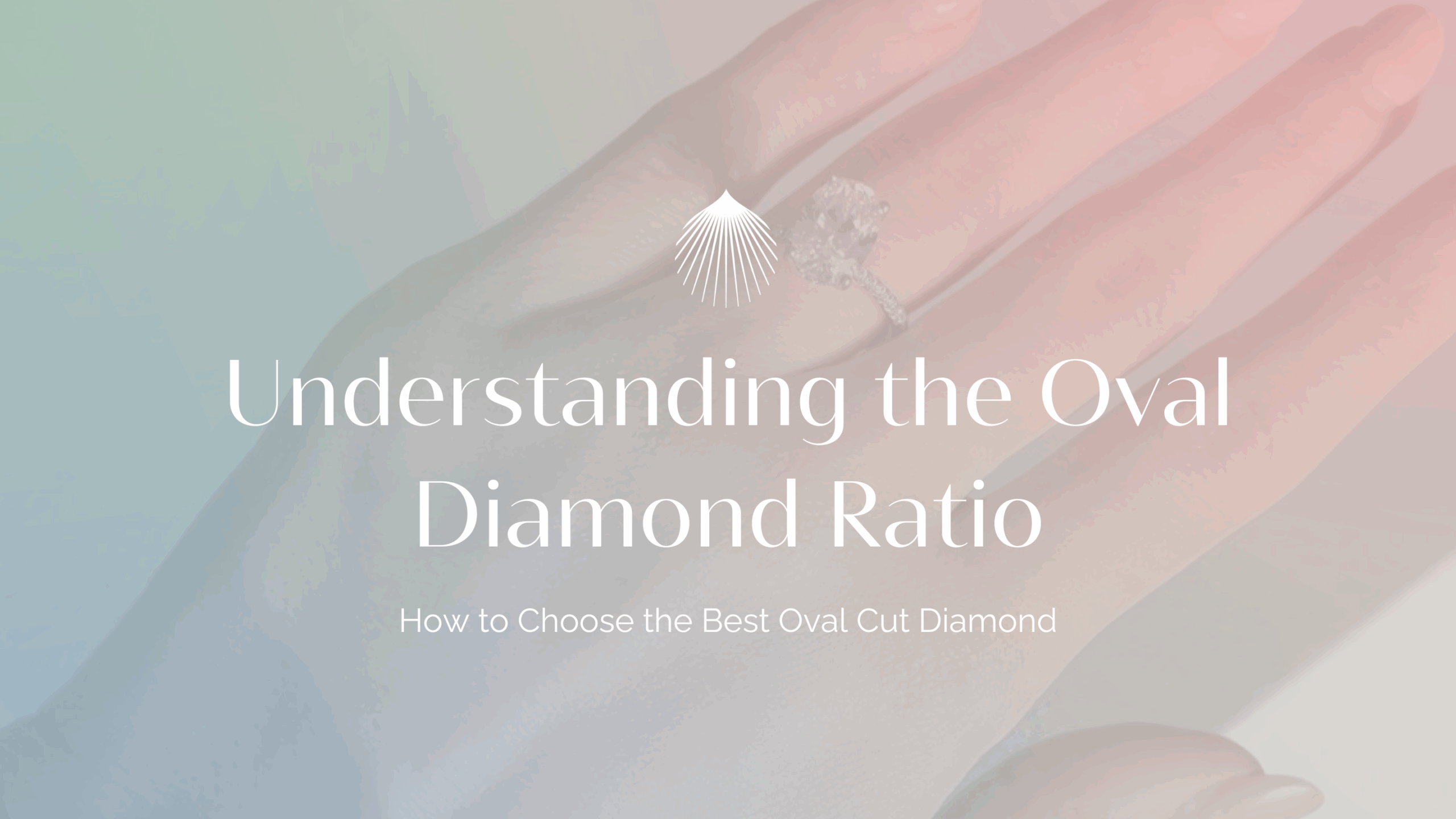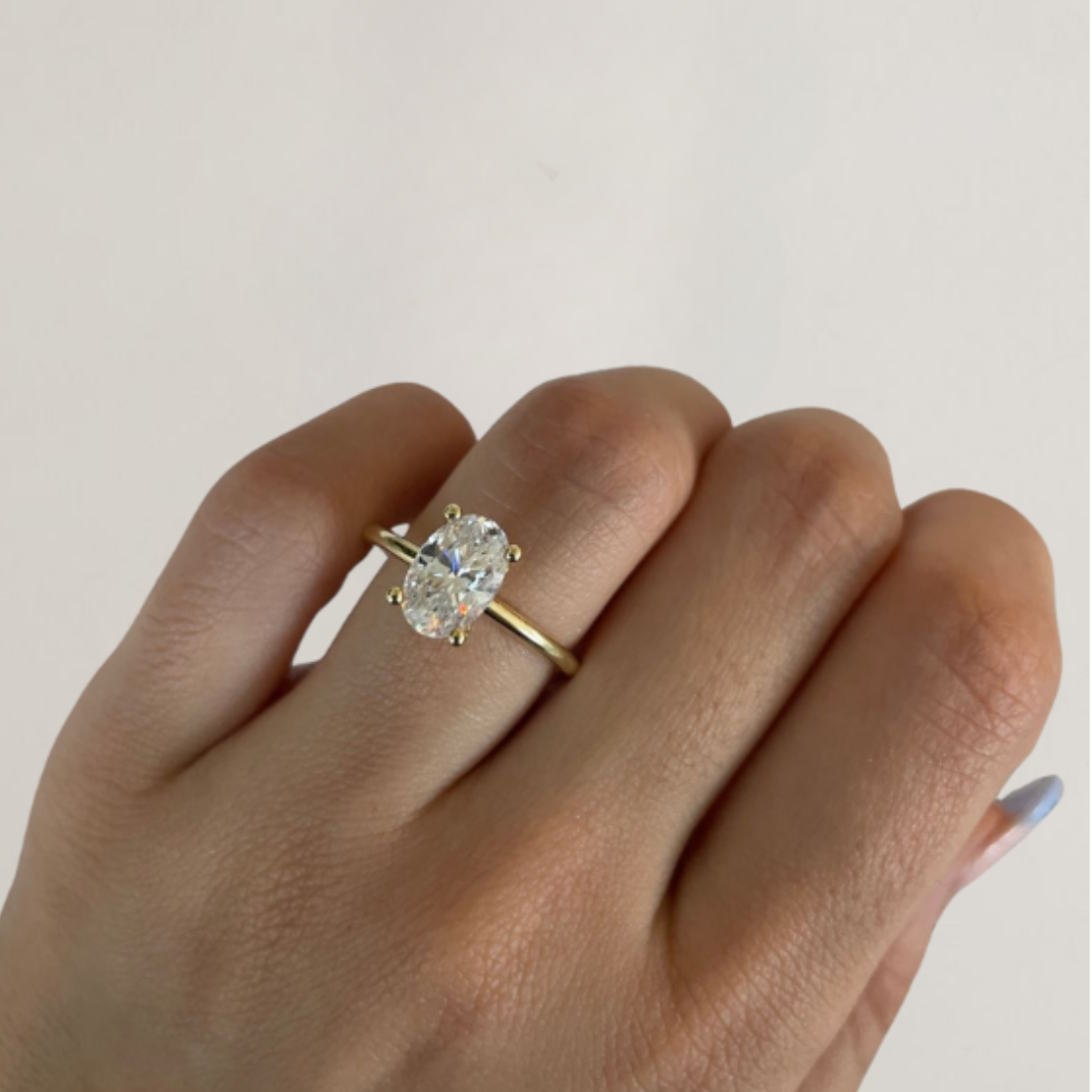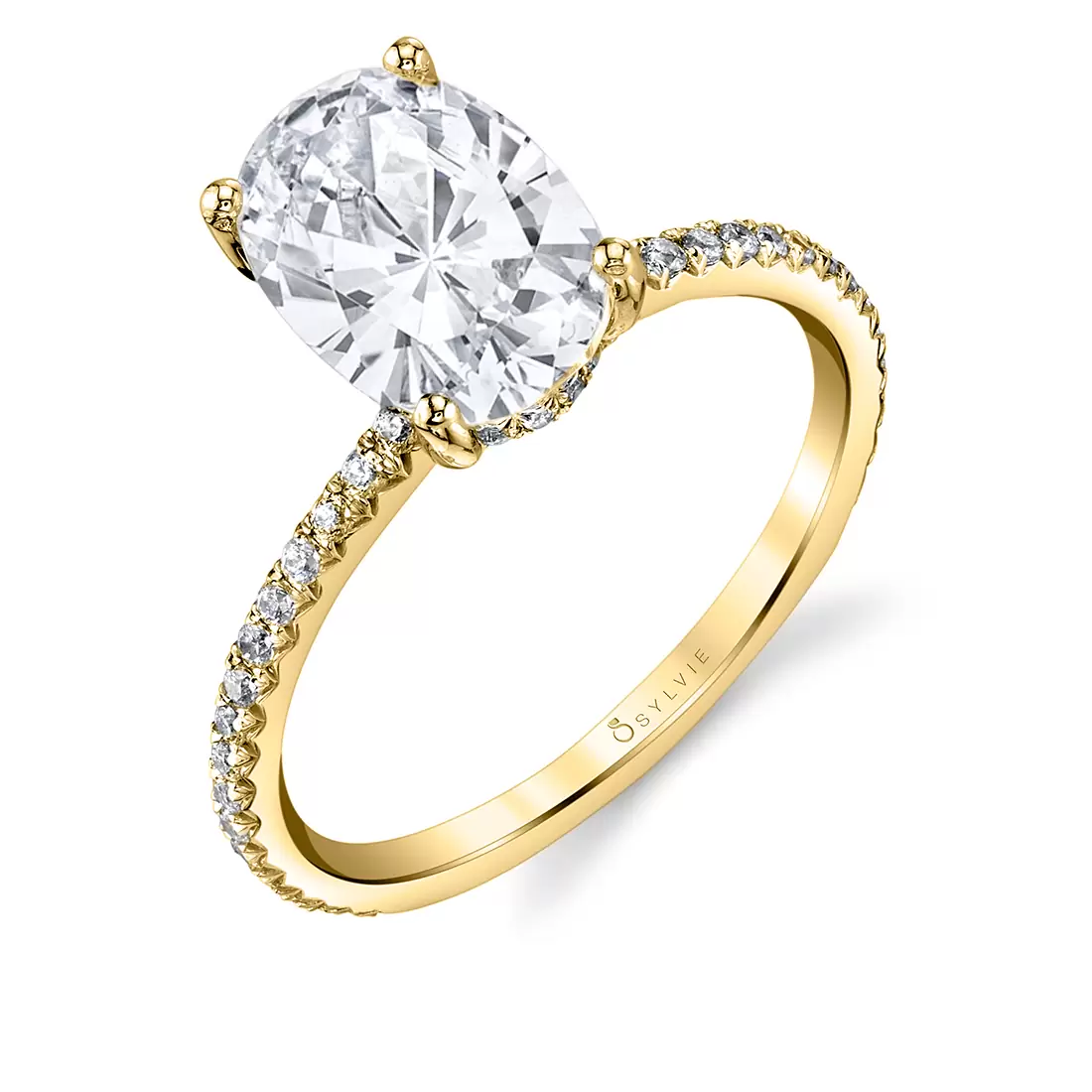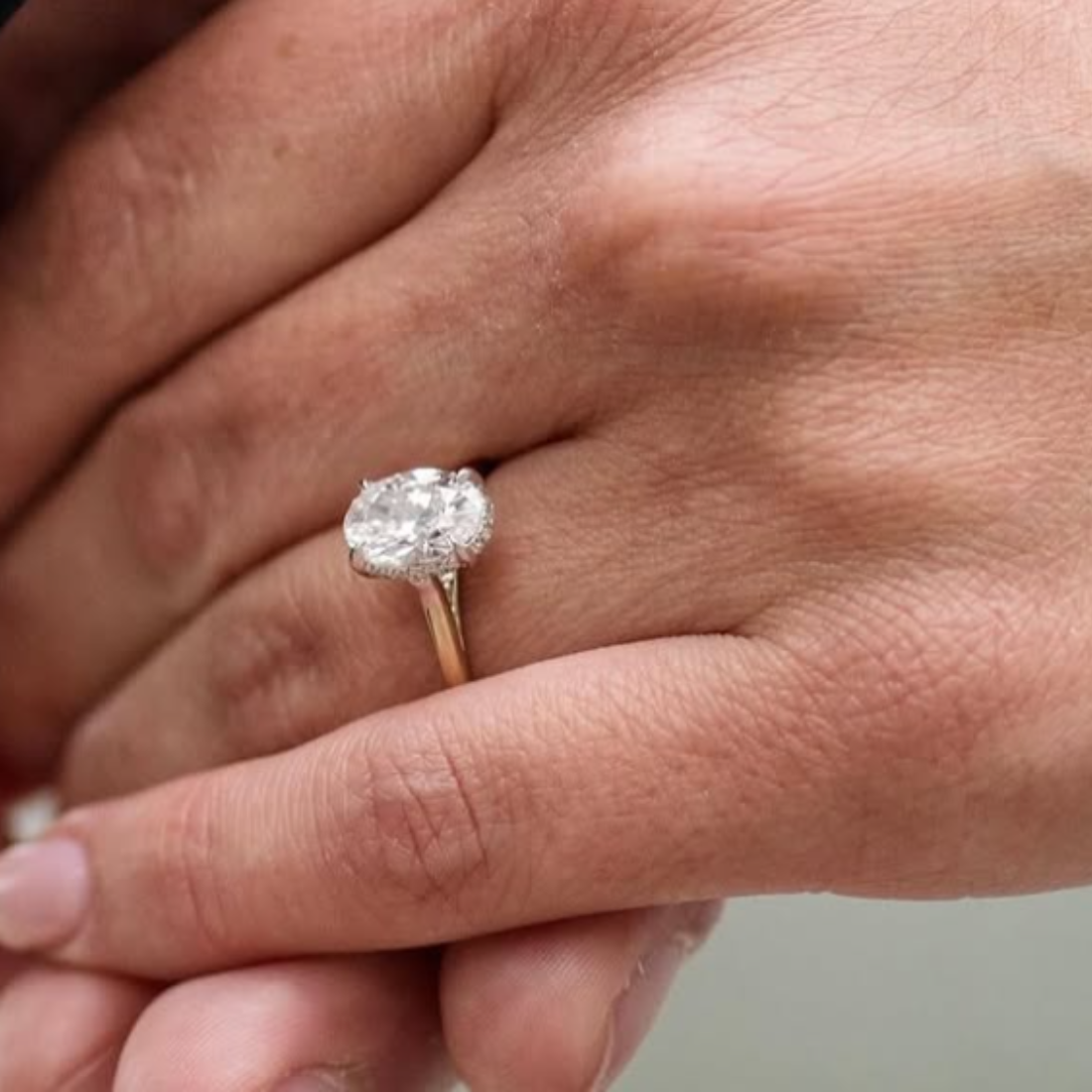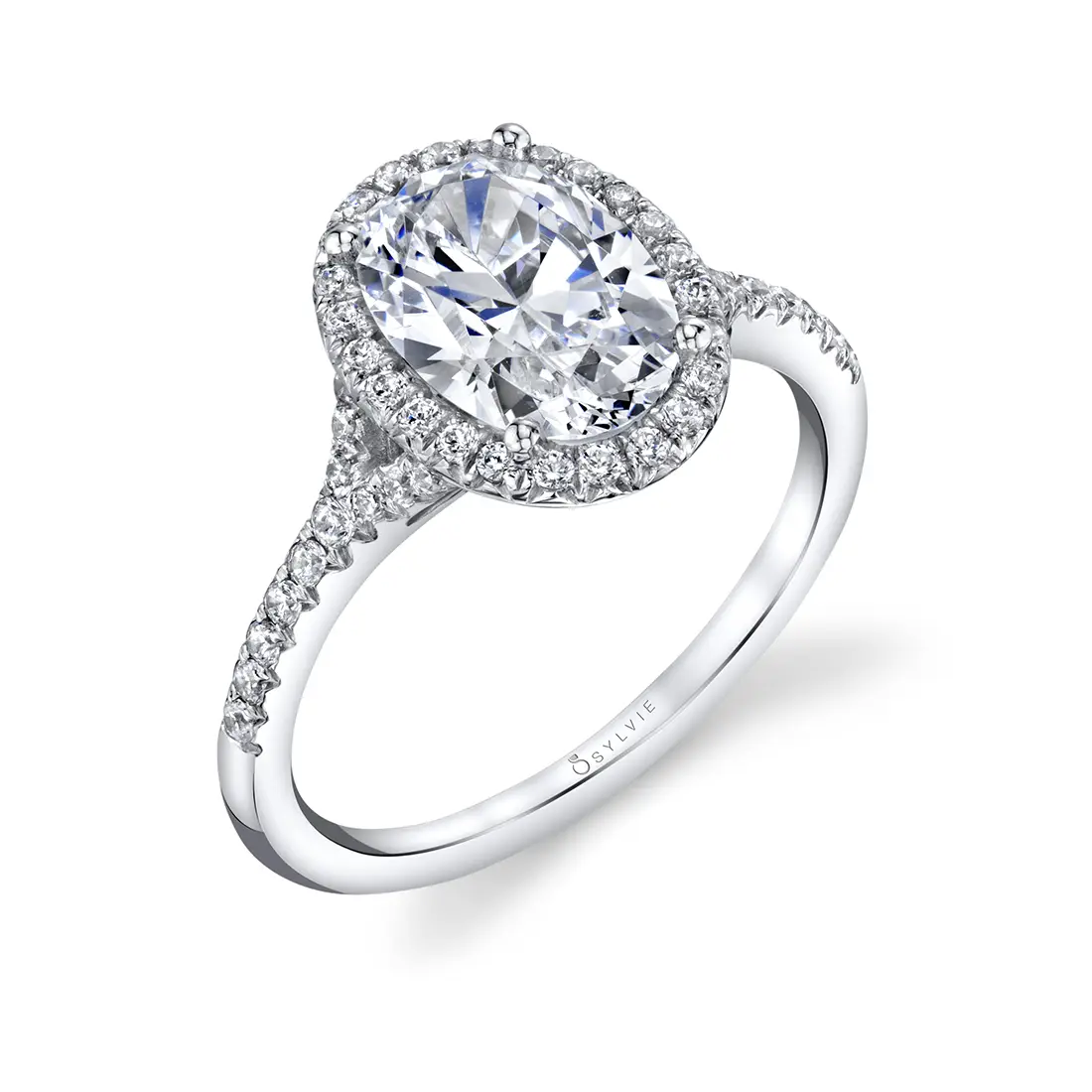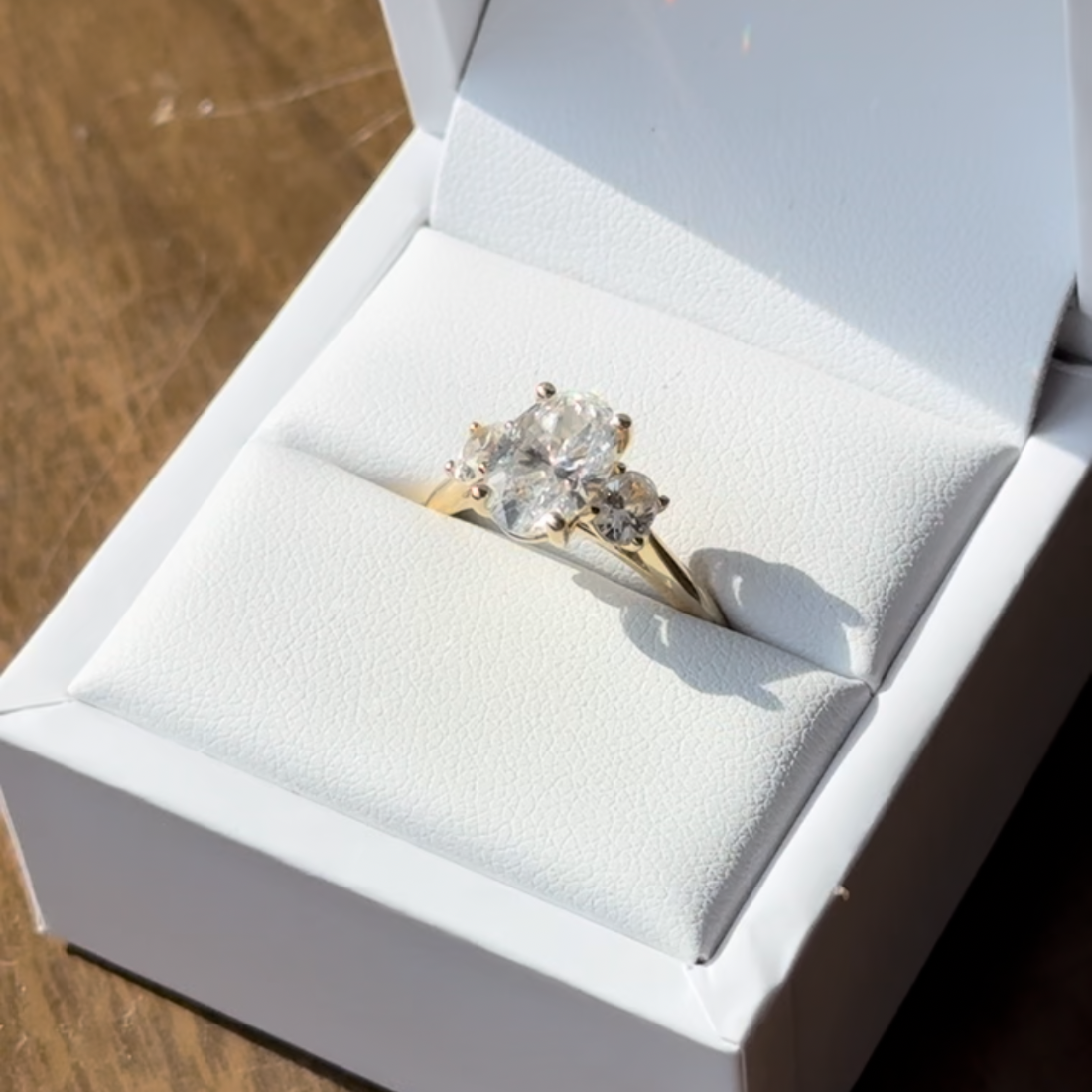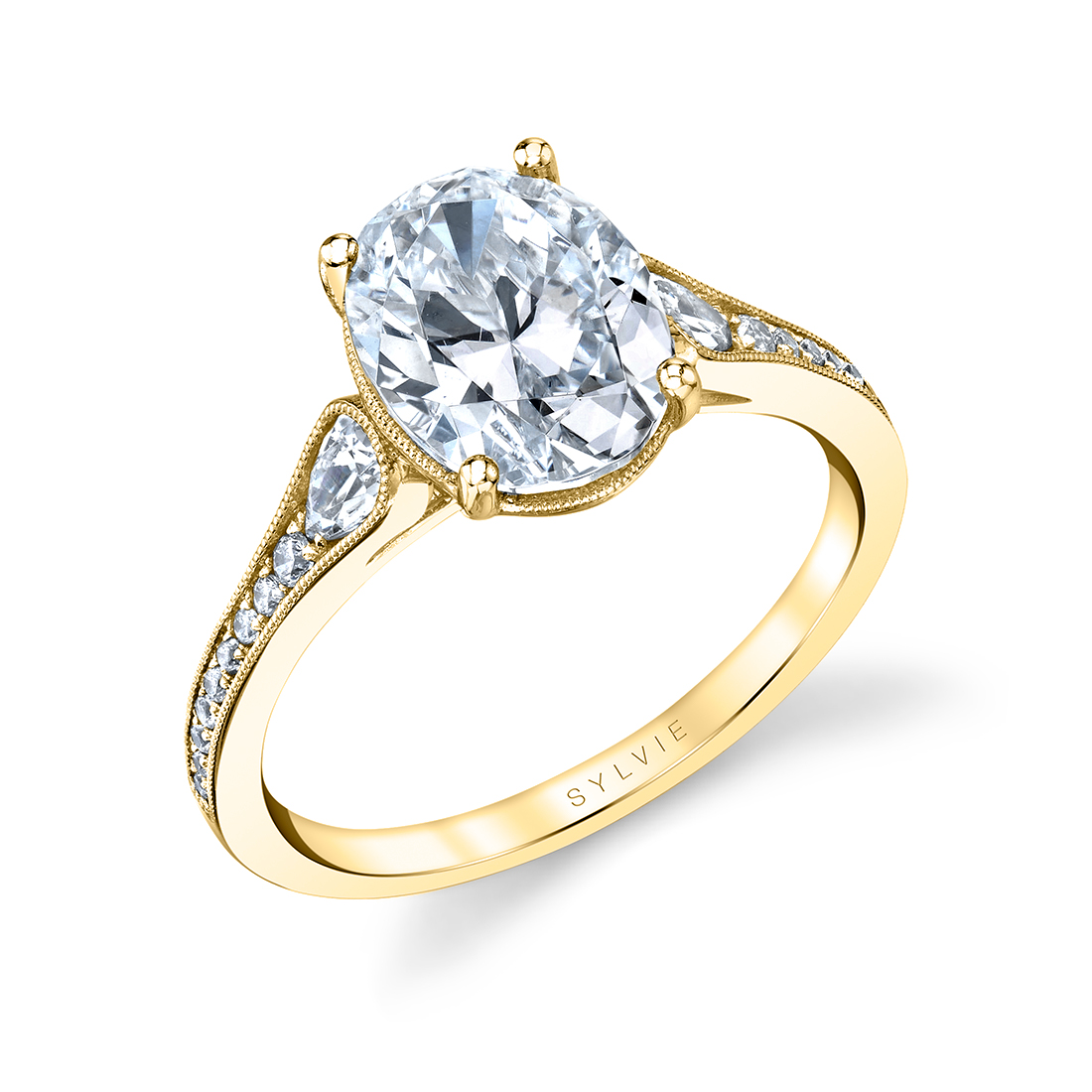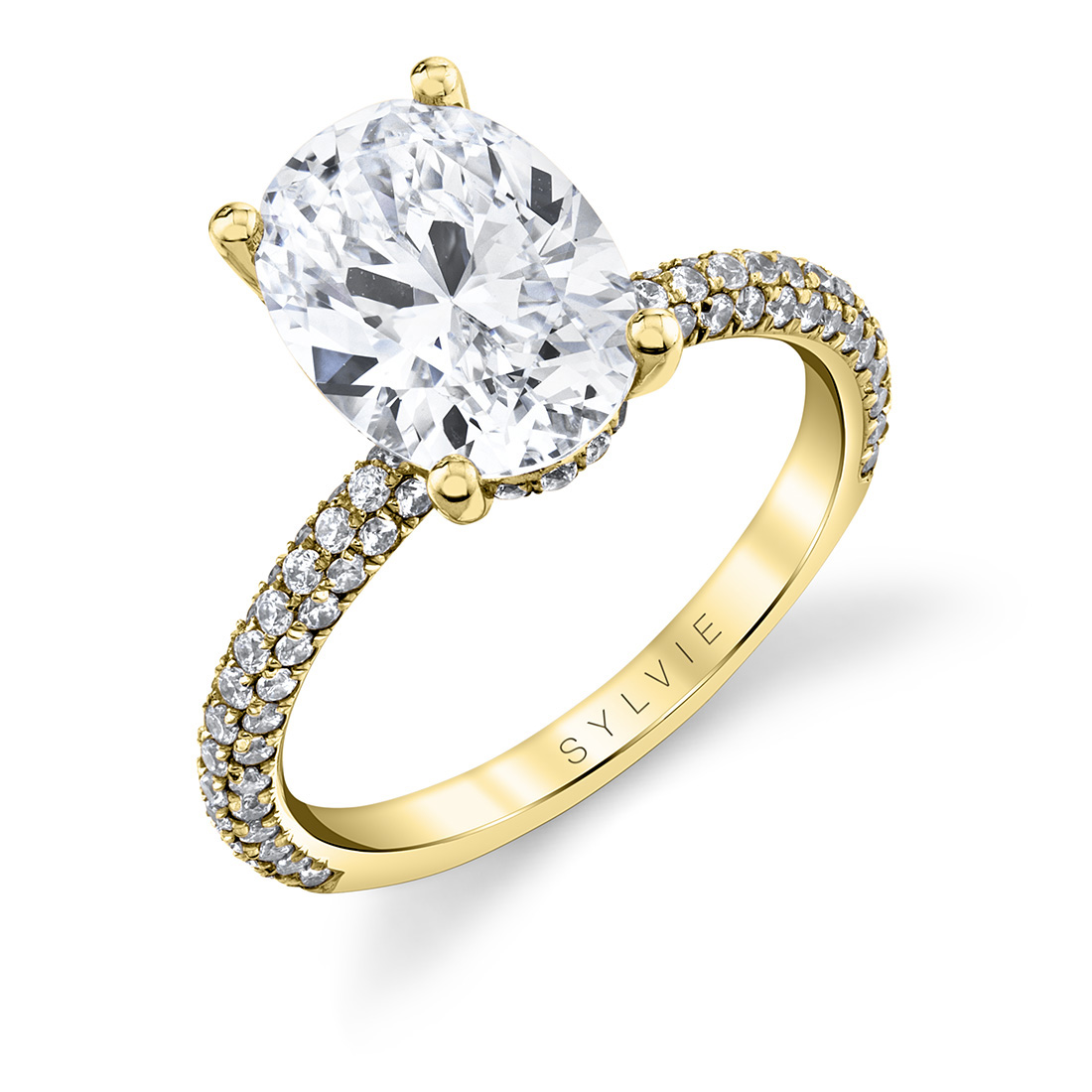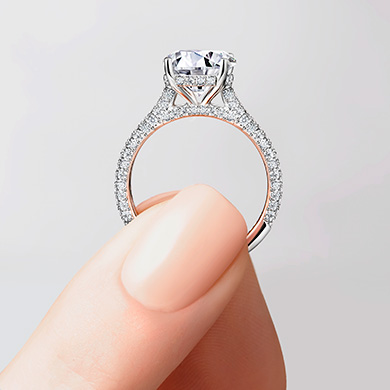The oval diamond ratio is one of the most essential details to consider when selecting an oval-cut diamond, as it directly affects the stone’s shape, visual impact, and sparkle. This measurement, found by dividing the diamond’s length by its width, determines whether a diamond looks soft and rounded or long and slender. A well-proportioned oval diamond ratio enhances symmetry and brilliance, resulting in a beautifully balanced and elegant stone that stands out in any setting.
But the right ratio is about more than numbers. It’s about how the diamond looks on your hand, how it catches the light, and how it fits your personal aesthetic. From small shifts in proportion to the way different settings showcase each shape, understanding the oval diamond ratio helps you choose a diamond that reflects your style and shines with confidence.
Why Oval Diamonds Are a Popular Choice
Oval diamonds are a modern favorite for a reason. They offer the perfect blend of classical elegance and contemporary flair. While round brilliant cuts have long dominated the diamond market, oval diamonds bring a distinctive silhouette that feels both refined and fresh.
Their elongated shape and soft curves create a flattering, finger-lengthening effect, while their brilliance rivals that of round diamonds. In recent years, their popularity has surged among younger audiences—fueled in part by trendsetters like Hailey Bieber, whose oval engagement ring drew attention to the cut’s graceful appeal. As a result, oval diamonds have become a go-to for engagement rings, necklaces, and earrings alike, appealing to those who appreciate both modern design and timeless beauty.
The History and Appeal of Oval Diamonds
The oval cut is a relatively recent innovation in diamond cutting, introduced in the 1960s by the renowned diamond cutter Lazare Kaplan. He sought to create a shape that combined the brilliance of the round cut with a more elongated, elegant silhouette. By refining the faceting pattern, Kaplan achieved a cut that enhances light reflection while maintaining a unique shape, resulting in the birth of the modern oval diamond.
This modified-brilliant cut retains the 58-facet structure of the round cut, ensuring the same level of sparkle and fire. However, the elongated design adds an extra layer of sophistication, making it a versatile choice for various jewelry designs. Oval diamonds offer the best of both worlds: a round diamond’s brilliance and the individuality of more creative shape.
Classical Oval Elegance Meets Modern Sophistication
Oval diamonds are adored for adapting to different styles and preferences. Whether you’re drawn to the simplicity of a solitaire setting or the drama of a halo design, the oval cut delivers sleek, lasting style that never feels outdated. The elongated shape creates a flattering effect, making fingers appear longer and slimmer, a feature that appeals to many brides-to-be.
Moreover, oval diamonds are an excellent option for those who value size. Their shape often makes them appear larger than round diamonds of the same carat weight, giving you a more substantial look for your investment. This perceived size advantage and brilliance contribute to their popularity among those seeking maximum impact in their jewelry.
A Shape for Every Setting
One of the most appealing aspects of oval diamonds is their adaptability. The cut works beautifully in various settings, from minimalist solitaires that let the center diamond shine to intricate designs featuring side stones or halos that enhance the ring’s overall sparkle. Oval diamonds are a great option to be utilized in vintage-inspired settings, for those who are looking to ad a touch of old-world charm with modern craftsmanship.
Their versatility isn’t limited to just engagement rings. Oval diamonds are a stunning choice for earrings, pendants, and bracelets, making them a perfect investment for jewelry that transitions effortlessly from day to night. This adaptability ensures that oval diamonds remain a classic yet contemporary choice for every jewelry lover.
With their spectacular sparkle, classic design, and flattering shape, it’s no wonder that oval diamonds are a popular choice for anyone looking to make a wise choice with their jewelry that will take them throughout life. Their rich history, coupled with their raising appeal, cements their place as a favorite in both traditional and modern designs.
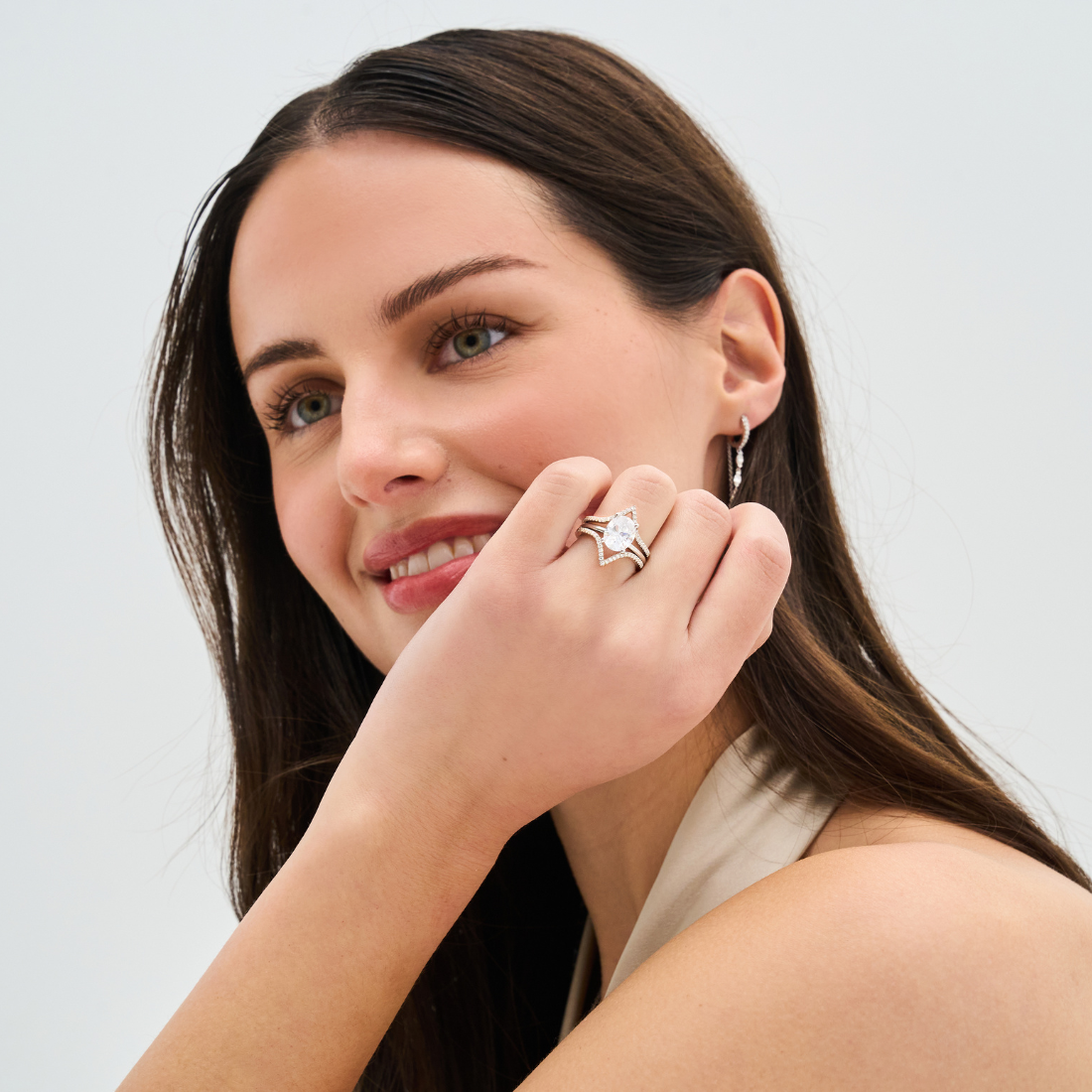
Oval Cut Solitaire Engagement Ring – Amelia
The Oval Diamond Ratio: What It Means and Why It Matters
The oval diamond ratio is a defining element in shaping the beauty, proportion, and overall brilliance of an oval-cut diamond. Calculated by dividing the diamond’s length by its width, this ratio determines whether the stone appears wide and soft or sleek and elongated.
A well-balanced oval diamond ratio not only enhances sparkle and symmetry but also affects how the diamond interacts with light and different ring settings. Choosing the right proportions ensures that the diamond harmonizes with your personal style, finger shape, and design preferences, making it a standout choice for every aspect of your jewelry collection.
Understanding the Oval Diamond Ratio: Precision and Aesthetic
Each oval diamond ratio creates a distinct look, with proportions typically falling within the 1.3 to 1.5 range. The ratio you choose impacts the diamond’s brilliance, visual balance, and presence on the hand.
- 1.3 to 1.35 Ratio – Slightly wider and more rounded, ideal for vintage-inspired settings or those who prefer a fuller, softer oval shape. This proportion offers a classic, romantic feel, making it an excellent choice for intricate, antique-style rings.
- 1.4 to 1.45 Ratio – Considered the most balanced and versatile, this range provides the ideal blend of elongation and brilliance. It complements a wide variety of ring settings, from refined solitaires to elaborate halo designs, lending itself seamlessly to any design vision.
- 1.46 to 1.5 Ratio – More elongated and sleek, creating a modern, dramatic effect. This proportion is popular among those seeking a bold, statement-making diamond, as its length can make the finger appear longer and slimmer while maximizing light reflection.
While the oval diamond ratio is a technical measurement, it is the key factor that turns a beautiful stone into your perfect diamond. Selecting the right ratio ensures that your diamond reflects you personally – your proportions, your preferences and your presence.
Ratios and Practicality: Enhancing Wearability
The oval diamond’s proportions play a key role in how comfortable and wearable the ring feels day to day. Longer ratios (around 1.45 to 1.5) create a slender profile that sits neatly on the finger, making it ideal for those who prefer a refined look without overwhelming their hand. This shape tends to be versatile, fitting well under gloves or alongside other jewelry without feeling bulky.
Wider ovals offer a sturdier presence that can feel more substantial on the finger, especially when paired with accent stones or detailed settings. Their broader surface distributes pressure more evenly, which can enhance durability for everyday wear. This makes wider proportions practical for those who want a ring that balances statement style with lasting comfort.
Finding Your Ideal Oval Diamond Ratio
Discovering the oval diamond ratio that best suits you is a personal process that blends design preferences with real-world considerations. The ideal ratio should align with your style, setting, and how the diamond appears on your hand. Viewing different oval cuts in person helps you better understand how proportions influence brilliance, balance, and visual impact.
This can easily be done with confidence by visiting Sylvie’s authorized retailers, where expert guidance can help you compare ratios and select a diamond that perfectly reflects your goals.
How to Find the Best Oval Diamond Ratio for You
Finding the ideal oval diamond ratio goes beyond looks, it’s about how the diamond fits into your daily life. While proportions shape the stone’s visual impact, factors like your lifestyle, ring setting, and personal taste are just as crucial. Whether you prefer a bold, architectural feel or something softer and more understated, the right ratio should complement your hand comfortably and suit how you live.
Understanding how different settings affect the diamond’s appearance can guide you to a balance of style, comfort, and lasting brilliance, ensuring your ring is as wearable as it is beautiful.
How the Ring Setting Impacts the Oval Diamond Ratio
A diamond’s length-to-width ratio remains the same on paper, but the ring setting can dramatically alter how that ratio looks in real life. Certain settings amplify the oval’s shape, while others add width or softness for a different visual effect. Understanding how specific styles enhance or downplay proportions can help you choose a setting that flatters both the diamond and your finger.
Solitaire Settings: Timeless Simplicity
A solitaire setting allows the oval diamond’s natural proportions to take center stage, making it ideal for balanced ratios between 1.4 and 1.45. This clean, simple design removes any distractions, showcasing the cut, symmetry, and overall brilliance of the stone. A solitaire setting highlights the elongation of the diamond, offering a refined and elegant look.
The Oval Cut Solitaire Engagement Ring – Carter is a standout choice for those who appreciate classic sophistication with a modern touch. This refined hidden halo solitaire features a stunning oval center diamond on a high-polish band, with a delicate halo tucked beneath the center stone to add a touch of hidden sparkle. Joanna blends simplicity with quiet brilliance, perfect for those who seek modern clarity and effortless style.
Halo Settings: Maximizing Brilliance
A halo setting elevates the impact of an oval diamond by surrounding it with a delicate circle of smaller diamonds, amplifying both its size and radiance.. This setting can also help balance out elongated ratios by adding width, creating a fuller and more dramatic effect.
For a stunning halo design that amplifies the beauty of an oval diamond, the Oval Cut Engagement Ring – Alexandra is an unbeatbale option. This 1.25-carat oval center stone is wrapped in a halo of round-brilliant diamonds. The diamonds in the halo are further elevated by the ones cascading down the brand, featuring a total carat weight of 0.28 –
Three-Stone Settings: Symbolic and Elegant
A three-stone setting creates a structured, symmetrical look, making it particularly effective for diamonds with a 1.4 ratio. By placing complementary side stones beside the center oval, this setting enhances balance and proportion, drawing attention to the oval’s organic shape while maintaining harmony in the overall design.
A prime example of this effect is the Oval Cut Three Stone Engagement Ring – Guinevere. For the true oval enthusiast, this stunning three-stone engagement ring showcases not just one, but three ovals. A 1.25-carat oval center accented by two matching oval diamonds, totaling 0.50 carats. This particular three stone design effortlessly celebrates the elegance of this iconic shape. Set on a classic high-polish band, the design balances stylish tradition with practical wearability, a refined look that’s as enduring as it is captivating.
Lifestyle and Practical Considerations
The right oval diamond ratio should feel as good as it looks. Whether you want a low-maintenance design for an active lifestyle or a statement piece for unforgettable moments your lifestyle and routines will influence which proportions and settings are most suitable. Thoughtful choices in both design and functionality ensure your ring looks elegant while also fitting seamlessly into your daily life.
For an Active Lifestyle: Durability and Protection
A lower-profile setting or a wider, more compact oval diamond ratio (1.3 to 1.4) is an excellent choice for those with hands-on careers or active lifestyles. This proportion provides a broader shape, making it less prone to snagging while still maintaining a chic and brilliant appearance. Choosing a bezel or halo setting also offers extra security, ensuring the diamond is well-protected from daily wear and tear.
One example of a practical yet sophisticated design is the Oval Cut Bezel Set Engagement Ring – Cliodhna. This ring showcases a thoughtfully set oval diamond in a sleek, protective bezel setting, ensuring durability while allowing the stone to reflect light easily. Blending clean design with lasting sentiment, the Cliodhna ring is made for those who appreciate understated beauty without the upkeep. It’s a quietly powerful symbol of enduring love, graceful, effortless, and built to last.
For a Bold and Statement-Making Look
If you’re drawn to statement-making style, a longer oval ratio (1.45 to 1.5) delivers bold impact with graceful precision. This stretched silhouette enhances the finger’s line, creating a refined yet commanding presence. Paired with delicate prongs or vintage-inspired details, these elongated ovals radiate brilliance and drama,allowing the diamond’s brilliance to take center stage.
For those drawn to vintage allure with modern elements, the Oval Cut Unique Engagement Ring – Esmerelda checks every box. Showcasing a 2.75-carat oval diamond, this ring marries modern refinement with vintage artistry. The handcrafted band, lined with 0.3254 carats of shimmering diamonds, adds depth and dimension, giving the piece an heirloom feel with a striking edge. It’s the ideal choice for those drawn to enduring beauty with a hint of grandeur.
Whether you prioritize durability for everyday wear or a dramatic statement piece, selecting the right oval diamond ratio and setting ensures that your ring aligns with your lifestyle, taste, and long-term comfort.
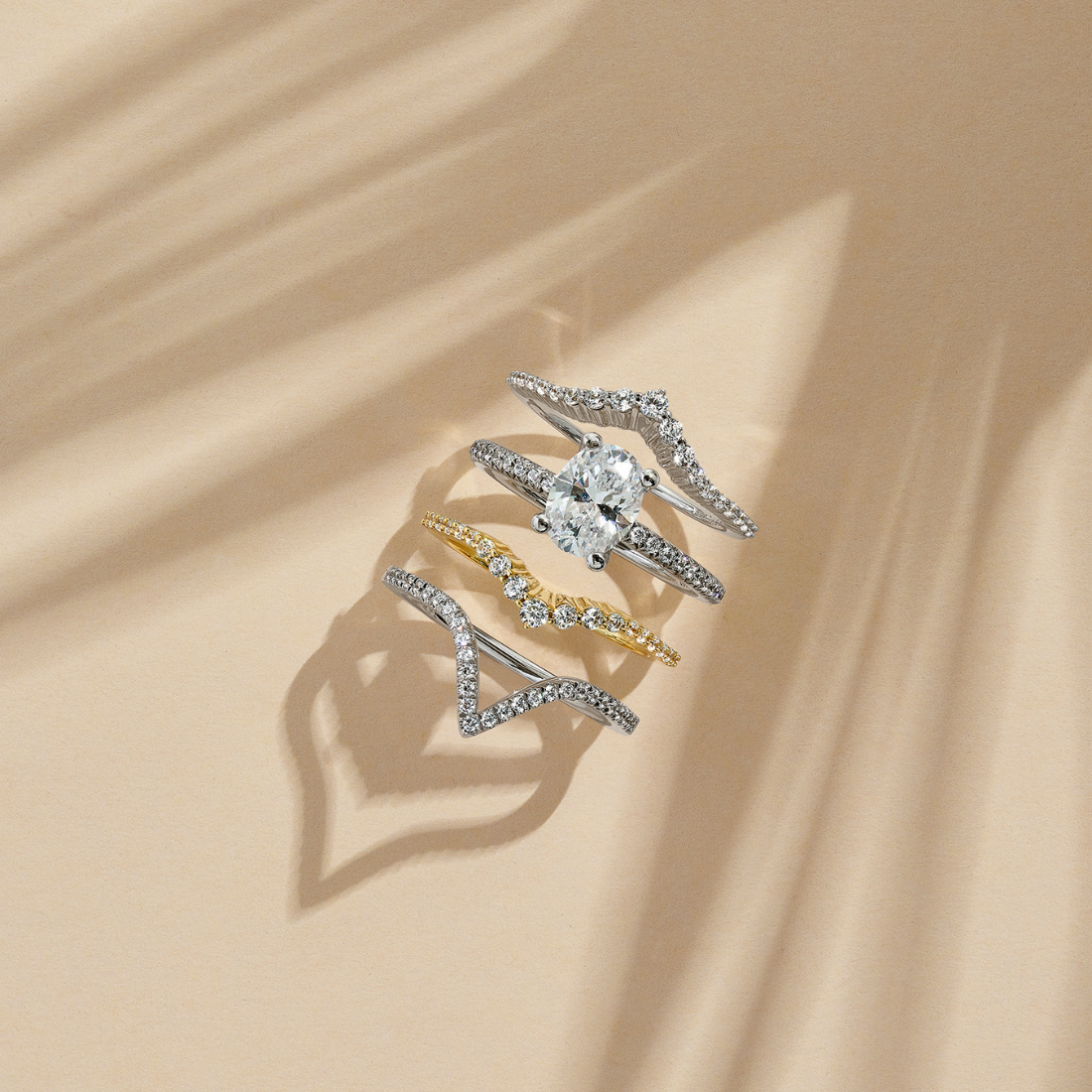
(From top to bottom) Curved Chevron Diamond Wedding Band, Oval Cut Classic Engagement Ring – Adorlee, Curved Diamond Wedding Band, and Curved Chevron Diamond Wedding Band
Symmetry: The Foundation of a Perfect Oval Diamond
Symmetry is the defining characteristic of a well-cut oval diamond. Each side of the diamond must mirror the other to create a seamless, eye-catching shape which ultimately influences light reflection and overall balance.
Even slight asymmetry can impact sparkle, distort proportions, and lead to uneven light performance. A well-cut oval diamond distributes light evenly, delivering a balanced mix of fire and brilliance. In contrast, a diamond with poor symmetry may exhibit lopsided proportions, light leakage, or an unbalanced silhouette, diminishing its overall appeal.
How Symmetry Affects Oval Diamond Beauty and Brilliance
Symmetry influences everything from how an oval diamond sparkles to how flattering it looks when worn. It plays a critical role in visual performance, craftsmanship, and wearability, making it a top factor to consider when selecting your diamond.
A clear symmetrical l oval diamond refracts light evenly, maximizing its brilliance and minimizing shadowy areas, especially important in cuts like ovals that are prone to the bow-tie effect. When symmetry is off, light escapes through the sides or bottom, leading to dull patches or visual imbalance. Precise alignment of facets ensures the diamond radiates evenly from all angles.
Beyond light performance, symmetry has a major impact on how the diamond appears to the naked eye. The oval’s shape depends on both sides being smoothly tapered and ends evenly rounded. Any imbalance, like a longer side, uneven bulge, or misaligned culet, can throw off the silhouette and affect how the diamond sits in its setting.
To evaluate symmetry, here are four key features to examine:
- Rounded Ends: The tips of the oval should be symmetrical and free from pointed or flat spots. Inconsistency at either end can disrupt the flowing shape.
- Tapered Sides: The diamond’s sides should gently and evenly curve toward the ends. Any uneven tapering will make the diamond appear lopsided.
- Aligned Facets: Facets should follow a consistent pattern on both sides. Misaligned facets create areas of light leakage, reducing sparkle.
- Centered Culet: The culet, the small point at the diamond’s base, must be centered. If it’s off, the entire diamond can appear tilted in its setting.
Symmetry also plays a significant role in how the diamond fits into a ring design. In solitaire settings, flaws are highly visible since the diamond stands alone. In halos or three-stone rings, a lack of symmetry may disrupt the flow between the center and side stones, making the design feel unbalanced.
Crafting a symmetrical oval diamond takes expert cutting and attention to detail. Master cutters must align every facet, angle, and proportion with precision. This level of craftsmanship ensures the diamond achieves its full potential for impact.
While minor asymmetries can go unnoticed to the casual eye, expert evaluation is essential. Trained professionals use magnification and advanced grading tools to inspect the diamond’s shape, symmetry, and facet alignment. At Sylvie’s authorized retailers, each diamond undergoes strict review to ensure it meets high standards of quality and design.
Ultimately, symmetry isn’t just a technical factor, it’s foundational to a diamond’s beauty and long-term satisfaction. Oval diamonds, in particular, magnify imperfections more than other shapes, which makes choosing a well-symmetrical stone even more important. Choosing a well-proportioned diamond ensures visual consistency, radiant light performance, and a polished, elevated look, key qualities that set an exceptional engagement ring apart.
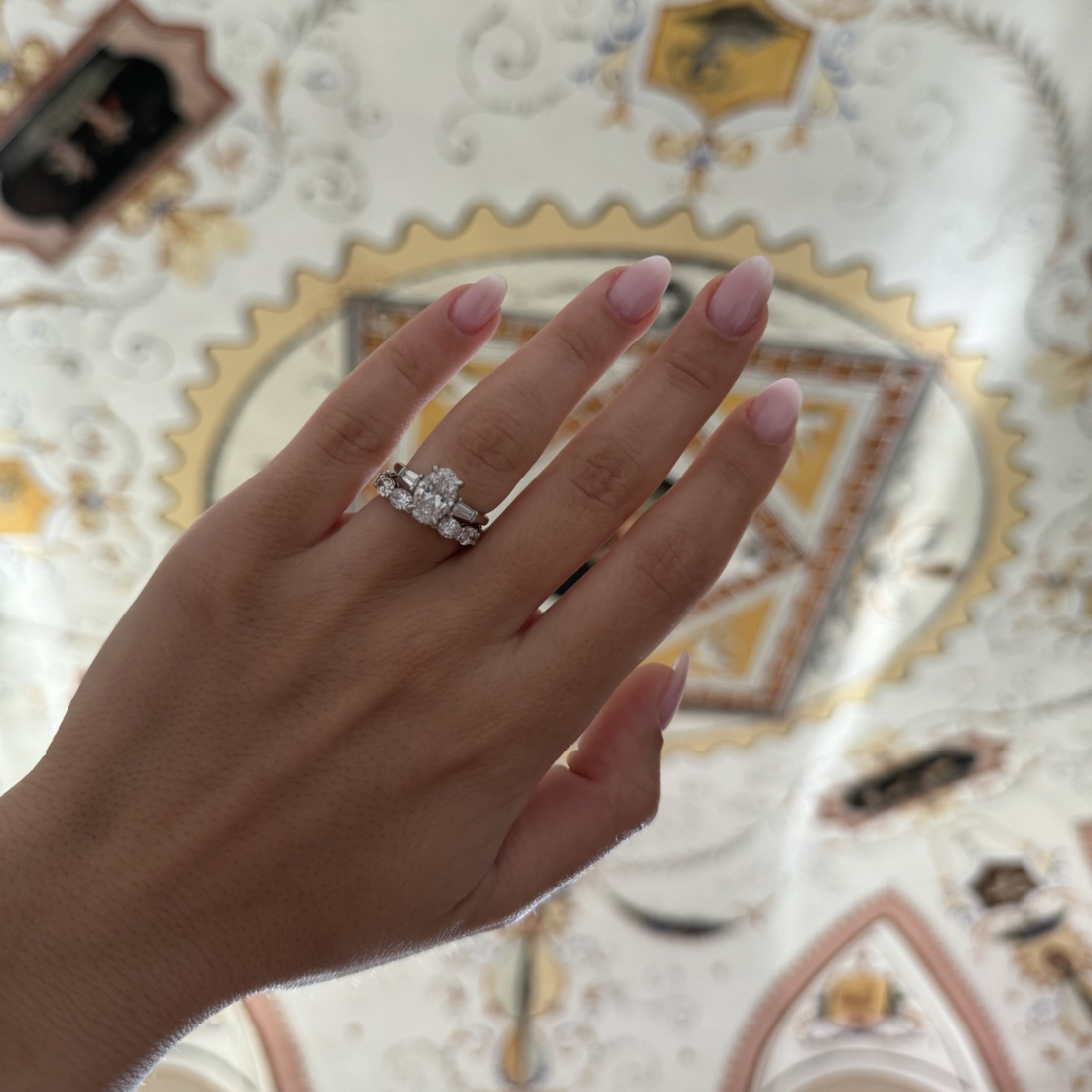
(From top to bottom) Oval Cut Three Stone Engagement Ring With Baguette – Nicolette and East To West Oval Shape Wedding Ring – 1.30 CT
The Bow-Tie Effect and Light Performance in Oval Diamonds
The bow-tie effect is a distinct visual characteristic seen in oval, marquise, and pear-shaped diamonds. It appears as a shadowy dark area running across the center of the diamond, resembling the shape of a bow tie. This effect occurs due to light leakage, where some of the light that enters the diamond does not reflect back toward the viewer’s eye, reducing the stone’s brilliance.
While the bow-tie effect is common in elongated diamond shapes, its severity varies depending on the cut quality, symmetry, and proportions of the stone. A well-cut oval diamond will display a subtle, almost invisible bow tie, allowing light to disperse evenly across the stone’s surface. However, a poorly cut diamond may have a prominent, dark bow tie, which negatively affects its sparkle and visual appeal.
Understanding the bow-tie effect and how to minimize its impact is essential when selecting an oval-cut diamond for an engagement ring or fine jewelry.
What Causes the Bow-Tie Effect in Elongated Diamonds?
The unique faceting structure of elongated diamond shapes causes the bow-tie effect. Unlike round diamonds, which distribute light evenly due to their circular design, oval diamonds feature elongated facets that direct light along their length.
If these facets are not properly aligned, some light escapes through the bottom or sides of the diamond rather than reflecting back toward the viewer’s eye. This light leakage leads to the formation of the bow-tie shadow in the diamond’s center.
Several factors influence the severity of the bow-tie effect. Cut quality plays a major role, diamonds with poor faceting or misaligned facets will exhibit a stronger, more visible bow tie.
Symmetry and proportions also come into play here, as asymmetrical diamonds or those with uneven depth-to-width ratios can struggle to reflect light properly, making the bow tie more pronounced. The depth and table percentage of the diamond must also be balanced; incorrect depth percentages can result in shallow light reflection, intensifying the shadow effect.
While some level of bow-tie effect is expected in all oval diamonds, a well-cut diamond will minimize the visibility of this shadow, allowing for a more brilliant and evenly lit appearance.
How the Bow-Tie Effect Impacts Diamond Appearance
Although the bow-tie effect cannot be completely eliminated in oval diamonds, several factors can help minimize its visibility while ensuring maximum brilliance.
The most effective way to reduce the bow-tie effect is to prioritize cut quality. Well-cut oval diamonds have carefully placed facets that distribute light evenly, softening the bow-tie effect. Diamonds with an Excellent or Very Good cut grade are less likely to show a pronounced bow tie, as their faceting structure is optimized for light reflection and sparkle.
Symmetry and proportions are also key in controlling the bow-tie effect. A symmetrical oval diamond with evenly tapered ends and well-aligned facets ensures that light is distributed harmoniously, reducing the prominence of the shadow. Proportions play a role as diamonds with a balanced depth percentage (58%–63%) and a table percentage (53%–63%) tend to exhibit less bow tie while maintaining optimal brilliance.
Evaluating a diamond under different lighting conditions is essential for assessing the bow-tie effect. A diamond may look brilliant under jewelry store spotlights but reveal a darker bow tie in natural daylight or soft ambient lighting. Viewing the diamond under various lighting conditions lets you see how the bow tie appears in real-life settings.
Since the bow-tie effect is difficult to assess online, working with a trusted jeweler is crucial. Sylvie Jewelry’s approved retailers are trained to identify well-cut oval diamonds, ensuring customers choose stones that match up with their wants and needs.
Why the Bow-Tie Effect Matters for Oval Diamonds
More than a simple detail, the bow-tie effect can make or break an oval diamond’s beauty.. A subtle bow tie can create dimension and depth, adding character to the stone. But when too pronounced, it can overshadow the diamond’s brilliance, dulling its light and taking away from its visual appeal.
A poorly cut oval diamond with a prominent bow tie will appear dull and lifeless, regardless of its carat weight or clarity grade. On the other hand, a skillfully cut oval diamond with a gentle, well proportioned bow tie will exhibit consistent brilliance and sparkle from every angle.
By prioritizing cut precision, symmetry, and proportions, you can minimize the bow tie’s visibility and ensure your oval diamond maintains its radiant beauty. Viewing the diamond under different lighting conditions is essential, as the bow-tie effect can vary depending on the environment.
Working with a trusted jeweler, such as Sylvie Jewelry’s authorized retailers, ensures you select a diamond with exceptional craftsmanship and minimal bow-tie visibility. A well-cut oval diamond should captivate with brilliance, elegance, and timeless sophistication, without distracting dark shadows.
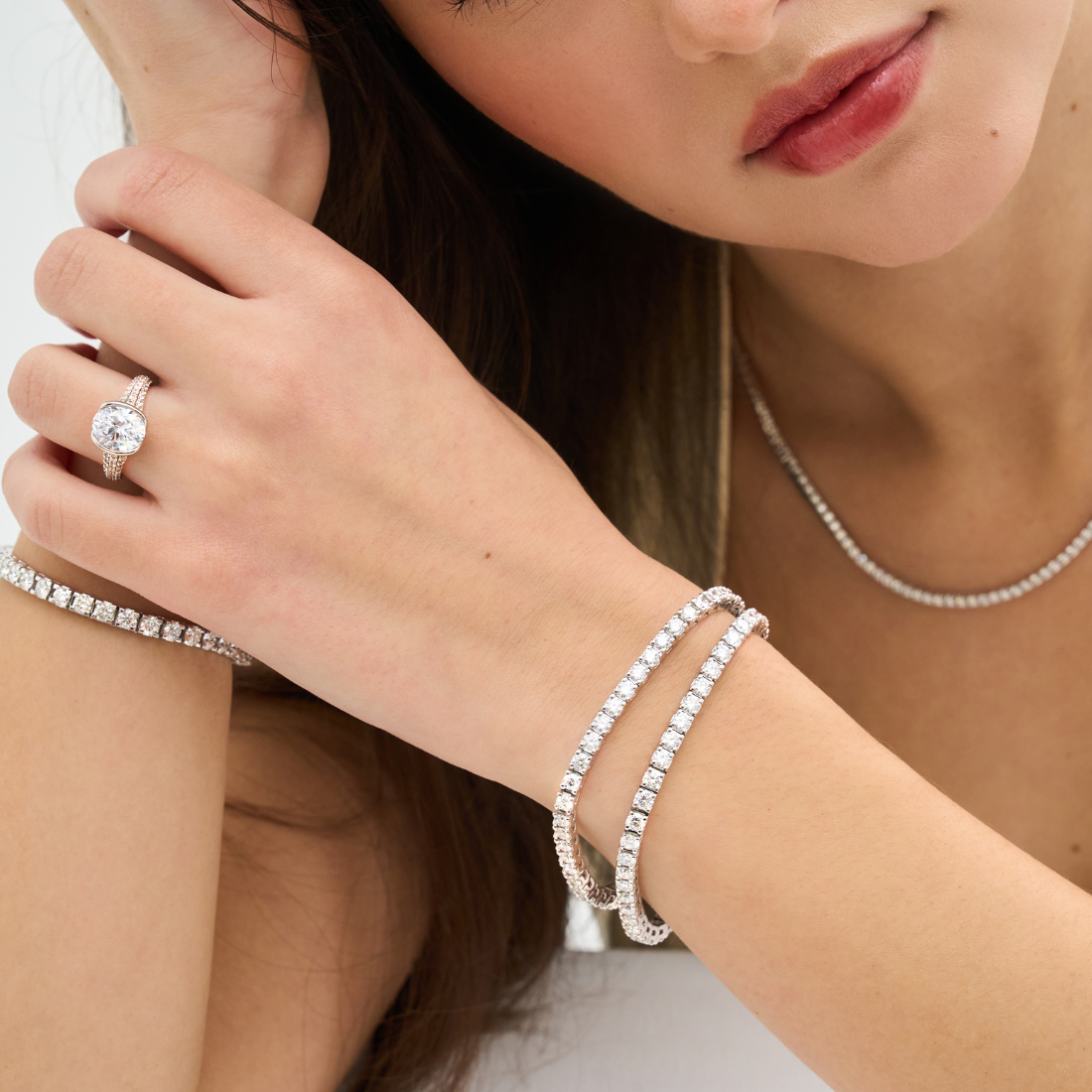
(from left to right): Classic Diamond Tennis Bracelet 6.0 CT, Shell Auranova Half Bezel Pavé Engagement Ring with Shell Tip Silhouettes – Mariselle, Diamond Tennis Necklace, Classic Diamond Tennis Bracelet 5.0 CT, and Classic Diamond Tennis Bracelet 8.0 CT
Color and Clarity: Finding the Perfect Balance
When selecting an oval diamond, understanding the balance between color and clarity is key to making an informed decision.
One of the standout features of the oval cut is its ability to mask imperfections and slight color variations, making it an excellent choice for those seeking a high quality diamond without exceeding their budget. The elongated shape and brilliant faceting of an oval diamond naturally diffuse light, drawing attention to its sparkle rather than its flaws.
While prioritizing cut quality is crucial, finding the right balance of color and clarity can elevate the overall beauty of your diamond and ensure it complements your chosen setting.
Color Considerations for Oval Diamonds
Oval diamonds are highly versatile when it comes to color. Their brilliant-cut faceting helps to diffuse any slight tints, allowing you to explore a wider range of color grades without compromising the diamond’s visual appeal. For those seeking a classic, crisp appearance, D-G color grades are ideal.
These near-colorless grades deliver a bright, icy look that pairs beautifully with platinum or white gold settings, enhancing the diamond’s brilliance.
If you’re working within a budget, diamonds in the H-K color range offer excellent value while maintaining a stunning appearance. These diamonds may exhibit a faint warmth, which can be beautifully complemented by yellow or rose gold settings.
The warmth of the metal enhances the diamond’s natural hue, creating a cohesive look. Many buyers find that diamonds in this range perfectly balance affordability and beauty, especially when paired with settings that amplify their unique character.
It’s also important to consider personal preference and how color interacts with the diamond’s setting. For example, a diamond in a prong setting will show more body color than one in a halo or bezel setting, where the surrounding metal or stones may influence the perception of color.
Clarity Considerations for Oval Diamonds
When it comes to clarity, oval diamonds are remarkably forgiving. Their brilliant cut features numerous facets that scatter light, effectively camouflaging inclusions, particularly those near the edges. This means you can choose diamonds with slightly lower clarity grades without worrying about visible imperfections detracting from the stone’s beauty.
Diamonds graded VS2 or SI1 are excellent choices for oval cuts. In these grades, inclusions are typically small and located in areas that are not easily visible to the naked eye. For many buyers, these clarity grades provide the best balance between price and appearance, offering significant savings without sacrificing quality.
If you prefer higher clarity grades, VVS1 or VVS2 diamonds ensure that inclusions are virtually undetectable even under magnification. However, this level of clarity often comes with a premium price tag and may not be necessary, given the oval diamond’s natural ability to hide imperfections.
For larger oval diamonds, clarity becomes slightly more important, as inclusions may become more visible due to the increased surface area.
Striking the Perfect Oval Diamond Balance
Ultimately, finding the perfect balance between color and clarity depends on your preferences, budget, and the setting you envision for your diamond. Oval diamonds offer the advantage of flexibility, allowing you to prioritize other factors such as size or cut quality while still achieving an optimal stone.
Oval Diamonds in Different Settings
The setting you choose for your oval diamond has a powerful impact on its visual character and overall appeal. From classic to modern, minimal to ornate, each setting enhances different aspects of the oval cut. Below are among the most adaptable and visually striking settings, each thoughtfully designed to enhance the beauty of this diamond shape.
Solitaire Settings: Classical Elegance
A solitaire setting strips everything back to spotlight what matters most: the diamond. With no distractions, the oval cut gets all the attention, its elongated form and lively sparkle made even more striking against a clean, polished band.
This setting highlights the natural beauty of the oval, making it a favorite for those who appreciate simplicity with serious presence.
Subtle customizations, like your choice of prongs or metal, let you tailor the look. Yellow gold brings warmth and richness; platinum offers a sleek, contemporary edge. For those drawn to refined design with lasting impact, an oval solitaire delivers quiet luxury that never goes out of style.
Halo Settings: Amplified Brilliance
Halo settings are all about amplification, boosting the brilliance of your oval diamond with a radiant circle of smaller stones. This luminous frame not only makes the center diamond appear larger, but also enhances its depth and sparkle from every angle.
This style is a great option for those who love dramatic brilliance and intricate detail. It also softens sharp proportions and brings extra dimension to more elongated oval cuts.
Customization is easy, pair with rose gold for a romantic effect or mix colored gemstones into the halo for a vibrant twist. Halo settings are ideal for those who want a balance of refined style and high-impact shine.
Three-Stone Settings: Symbolism and Symmetry
Three-stone setting is as rich in meaning and visual harmony. The center oval diamond is flanked by two side stones, symbolizing your past, present, and future.
This design enhances the proportions of the center diamond while creating a symmetrical, balanced appearance. You can choose tapered baguettes, pear-shaped stones, or matching ovals to complement your central gem.
It’s a flexible choice that bridges classic and modern styles, ideal for those who want meaningful design paired with a polished, intentional look.
Vintage-Inspired Settings: Old-World Charm
Vintage-inspired settings, often featuring intricate details like filigree, milgrain edges, or engraving. These designs evoke a sense of old-world elegance while highlighting the dynamic shape of the oval diamond.
Vintage-inspired settings often incorporate smaller accent stones or ornate bands, adding depth and character to the piece. Platinum and yellow gold are popular metal choices for this style, as they complement the antique feel of the design.
Bezel Settings: Modern Security
Bezel settings surround the oval diamond in a protective rim of metal, making them a sleek and secure choice. This style is ideal for active lifestyles or anyone looking for a low-maintenance design.
While the bezel setting offers added protection, modern craftsmanship ensures your diamond still catches the light beautifully. It’s a smart option for those who value sleek design, everyday durability, and understated luxury.
Finding the Perfect Setting for Your Oval Diamond
Each oval diamond carries its own character and the setting is what gives it that personality. Whether you’re drawn to the clean simplicity of a solitaire, the brilliance of a halo, or the charm of vintage-inspired details, your setting should do more than just hold the stone, it should echo your style, your story, and the way you want your ring to feel every day.
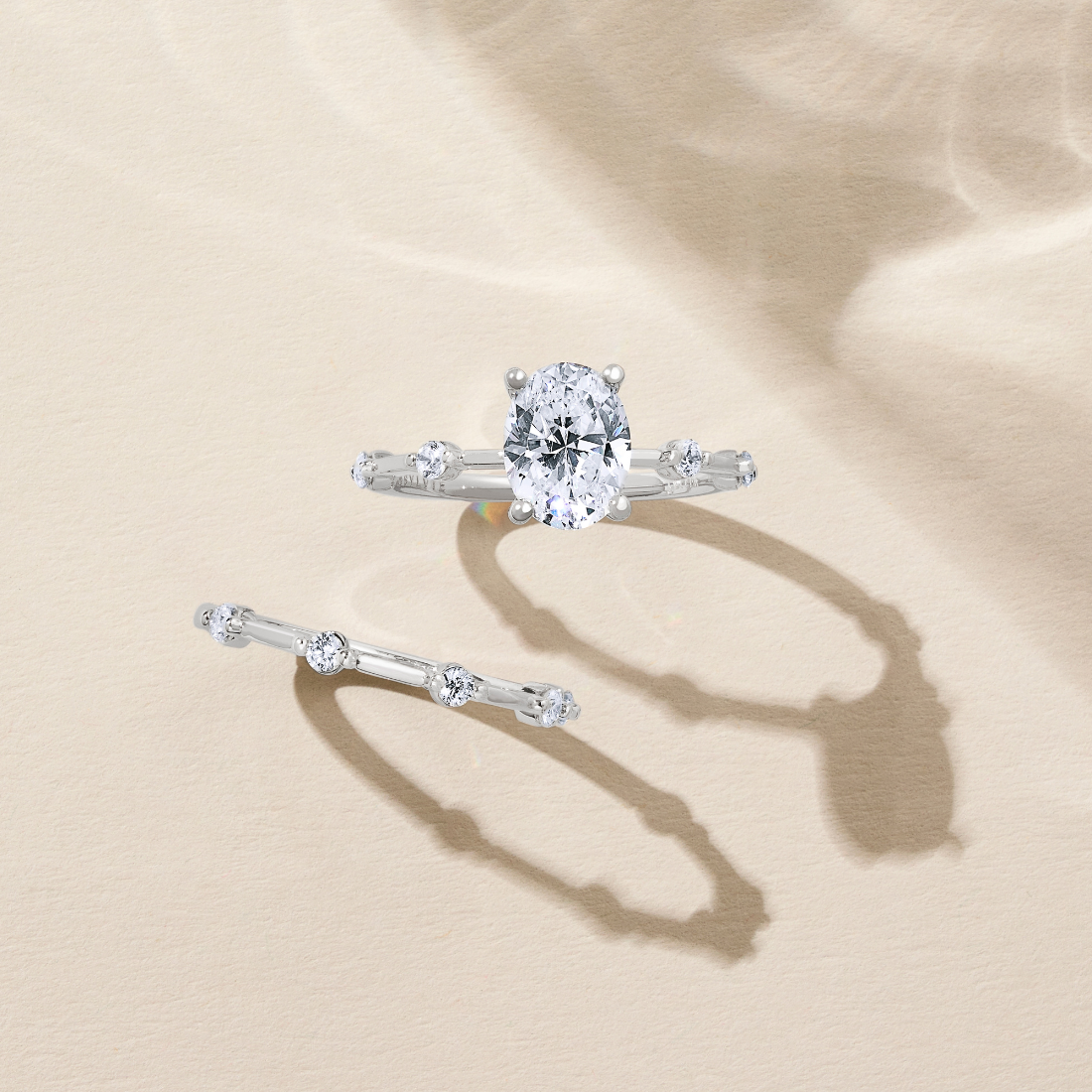
(From top to bottom): Oval Cut Engagement Ring – Eniko and Classic Spaced Diamond Wedding Ring – Eniko
Final Thoughts on the Oval Diamond Ratio
Selecting the perfect oval diamond ratio is an art as much as a science. By considering proportions, symmetry, and other factors like color and clarity, you can find a diamond that perfectly suits your style and preferences.
At Sylvie Jewelry, we’re here to help you discover the ideal oval-cut diamond for your engagement ring. Explore our collection today and create a timeless piece that reflects your love story.
